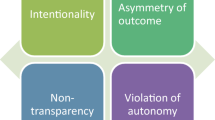Abstract
28 college undergraduates were required to respond with either “salt” or “no salt” to 50 presentations of distilled water. The ratio of “salt” responses (false alarm rates) ranged from .00 to .62 with a median of .24; 82% of the Ss made at least one “salt” response. It is argued that the significance of these results is obscured by using the “false alarm” metaphor: such a metaphor carries the notion of willful misbehavior or culpable heedlessness. The errors of perception are better conceptualized as the probabilistically predictable outcome of implicit and explicit role demands. The metaphor “false alarm” would then appear to be infelicitous to describe errors of perception.
Similar content being viewed by others
References
BARTOSHUK, L. M., McBURNEY, D. H., & PFAFFMANN, C. 1964. Taste of sodium chloride solutions after adaptation to sodium chloride: Implications for the “water taste.” Science, 143, 967–968.
LAWSON, J. L., & UHLENBECK, G. E. 1950. Threshold signals. New York: McGraw-Hill.
McBURNEY, D. H., & PFAFFMANN, C. 1963. Gustatory adaptation to saliva and sodium chloride. J. exp. Psychol.., 65, 523–529.
ORNE, M. T., & SCHEIBE, K. E. 1964. The contribution of nondeprivation factors in the production of sensory deprivation effects: The psychology of the “panic button.” J. abnorm. soc. Psychol.., 68, 3–12.
PARKS, T. E. 1966. Signal-detectability theory of recognition-memory performance. Psychol. Rev., 73, 44–58.
ROSENTHAL, R., & FODE, K. L. 1963. Psychology of the scientist: V. Three experiments in experimenter bias. Psychol. Rep. 12, 491–511.
RYLE, G. 1954. Dilemmas. Cambridge: University Press, Chapter II.
SARBIN, T. R. 1964. Anxiety: Reification of a metaphor. Arch. gen. Psychiat., 10, 630–638.
SARBIN, T. R. 1966. On the meaning of “hallucinations.” Ms.
SARBIN, T. R., & JUHASZ, J. B. 1966. The historical background of the concept of hallucinations. Ms.
SWETS, J. A. 1961. Is there a sensory threshold? Science, 134, 168–177.
SWETS, J. A., TANNER, W. P., & BIRDSALL, T. G. 1961. Decision processes in perception. Psychol. Rev., 68, 301–340.
TANNER, W. P., & SWETS, J. A. 1954. A decision-making theory of visual detection. Psychol. Rev., 61, 401–409.
TRAVERS, P. L. 1934. Mary Poppins. New York: Reynal & Hitchcock, Chapter I.
TURBAYNE, C. M. 1962. The myth of metaphor. New Haven, Conn.: Yale University Press.
Author information
Authors and Affiliations
Rights and permissions
About this article
Cite this article
Juhasz, J.B., Sarbin, T.R. On the False Alarm Metaphor in Psychophysics. Psychol Rec 16, 323–327 (1966). https://doi.org/10.1007/BF03393675
Published:
Issue Date:
DOI: https://doi.org/10.1007/BF03393675




